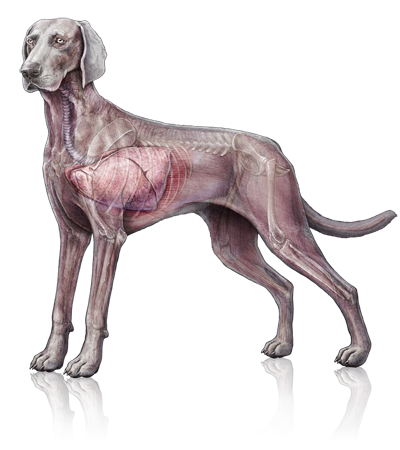
The respiratory system functions to carry vital oxygen into the body and expel carbon dioxide, a metabolic waste, out of the body. Functionally, the respiratory system is divided into two portions: the upper and lower airways. The upper airway begins as air enters the nasal passages and mouth and flows through the trachea (windpipe). The upper respiratory tract warms, filters, and moisturizes inhaled air. As air continues down the trachea, it enters the lung lobes: the lower respiratory tract. Within the lungs, inhalation brings vital oxygen to the blood; exhalation removes carbon dioxide from the body.
Physical signs associated with respiratory disease include: sneezing, nasal discharge, changes in the sound of the voice, coughing, noisy breathing, exercise intolerance, changes in breathing patterns, and labored breathing. Disorders of the respiratory system may involve the upper and/or lower airways. Physical examination findings aid in the localization of the disease process.
Common abnormal conditions associated with the canine respiratory system include:
- Infectious: viral (e.g.: Adenovirus), bacteria (e.g.: Mycoplasma), fungi (e.g.: Blastomycosis), protozoan (e.g.: Toxoplasmosis), and parasites (e.g.: Heartworm infection)
- Air flow interference: collapsing trachea, laryngeal paralysis, foreign bodies, tumors
- Bronchitis
- Pneumonia
- Cancer
Lungs

Inhaled air travels from the upper airways (nasal passage and trachea) to the lower airways of the lungs. Deep in the lung tissues, inhaled oxygen enters the blood stream to be exchanged with carbon dioxide, a metabolic waste that is exhaled out of the body. Dogs with lung disease may cough, have labored breathing, and experience exercise intolerance. Radiography (x-rays) allows your veterinarian to visualize the lungs and diagnose problems such as pneumonia, heartworm infection, bronchitis, and cancer.
Trachea

The trachea (or windpipe) forms the upper portion of the respiratory tract; the lungs form the lower portion. The trachea provides a conduit for airflow into the lungs. Blockage of this pathway (e.g.: from a foreign object) disrupts airflow and requires emergency attention. Within the tracheal tube, there are microscopic hairs within a layer of mucus that trap inhaled particles before they can enter the lungs and cause damage. Particulate matter trapped in the mucus is moved by these hairs back up to the mouth to be swallowed. This clearing mechanism is important in disease prevention. Dogs unable to clear the debris trapped in the trachea (e.g.: collapsing trachea) risk developing infections within the lungs.
What's Next
Call us to schedule an appointment
Meet with a doctor for an initial exam.
Put a plan together for your pet.

